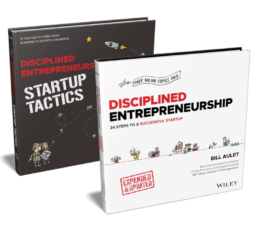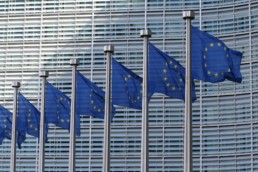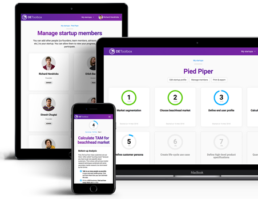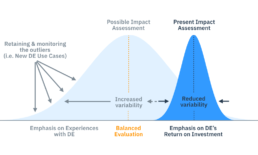Designing Industrial Policy Strategy: The Final Frontier for Disciplined Entrepreneurship
The Disciplined Entrepreneurship Toolbox
Stay ahead by using the 24 steps together with your team, mentors, and investors.
Sign up for our newsletter
We know there is no shortage of reasons to apply the Disciplined Entrepreneurship (DE) framework for various innovation-driven processes both for established or under-development organizations or to fit the needs of the ready to go, exploratory and corporate entrepreneurs.
While there is a growing body of evidence regarding the value of DE and its impact, little is known about its potential application as an industry policymaking framework and an engagement strategy that can inform strategic policymaking dialogues.

Photo by Guillaume Périgois on Unsplash).
As an external expert on innovation at the European Commission (EC), my role involves working closely with EC project managers and innovation experts across Europe in programs designed to bridge the gap between research, innovation, and market and support the scale-up of the first application of several types of innovation projects.
Recently and in the context of the renewed European Industrial Policy Strategy adopted in 2017, I was invited to be part of EC’s strategic dialogue series aiming to identify policy needs and underpin a comprehensive framework feeding into future policy work on Cultural and Creative Industries (CCIs) and the broader vision for the industry of tomorrow.
It is through this occasion that I have experienced first-hand the processes of industry policy design. Right from the start, I decided to base my contribution more on methods and research into how organizations create value and sustain growth than my personal experiences and idiosyncratic view of the world. Undoubtedly, to be useful in a policy-focused strategic dialogue, one needs to combine domain practical expertise with evidence-based strategic thinking.
“To be useful in a policy-focused strategic dialogue, one needs to combine domain practical expertise with evidence-based strategic thinking.”
Why the end-to-end design of DE can become a fundamental concept for industrial policy strategy
For history, the never-ending knowledge quest that would help me navigate businesses in permanent “white water”, almost accidentally led me to the concept of Disciplined Entrepreneurship (DE).
Initially, the idea that entrepreneurship can be taught in a rigorous, systematic, and academically grounded way came as a positive shock to me when a friend introduced me to DE, during an Executive Education class at MIT Sloan, back in 2014.
Less than a year later, I was attending Prof. Bill Aulet’s Teacher’s class on Disciplined Entrepreneurship aimed at entrepreneurship and innovation educators. Little did I know that this class alone would serve as a perspective-adjustment mindset that glued together previously isolated blocks of knowledge and bits of information and would be so influential that saw DE as the foundation of my domain expertise in the field of corporate innovation ever since.
What I found most surprising is that the answer to many of my questions did not come from traditional business management theory or the countless industry reports but the emerging domain of entrepreneurship.
In general, policies typically aim to produce a variety of positive outcomes such as improve competitiveness and access to markets, promote and support the values of diversity and inclusion, foster economic and social prosperity and technological advancement among others. It is, in essence, an evolving feedback loop and iterative process of combining knowledge accumulated from past policies, industry data, and stakeholder insights and translating these inputs into evidence-based, actionable, and evaluable policies for the future.
“Policy design is, in essence, an evolving feedback loop and iterative process of combining knowledge accumulated from past policies, industry data, and stakeholder insights and translating these inputs into evidence-based, actionable and evaluable policies for the future.”
A principal characteristic of DE is that market intelligence, and business operations run conjointly throughout the process and reside at both ends of the spectrum (client-side and business-side). Therefore, the DE framework acts as a link between the two and powers the spiraling innovation iterative process.
As such, many key DE concepts can facilitate an effective industrial policy design. A thorough understanding of things like Beachhead Markets, Quantified Value Propositions, Full Life Cycle Use Cases, Decision-making Units and Processes, Minimum Viable Business Products, and Product-market fit, to name a few, can improve the chances of policy success, even if they do not assure it.
To inspire effective policy design, it is imperative to have an end-to-end understanding of value creation, capture and delivery, and a common language to facilitate efficient strategic dialogues. DE provides that framework and common language.
How can DE facilitate the process of evidence-based policymaking?
Process and evidence-based policymaking is a growing global trend that is marked by a shift in focus from inputs to impact outcomes and used to guide policy decisions and design, determine areas of focus and budget allocations and influence future initiatives.
The use of the DE framework as a general guide for my contribution provided me with a core set of tools and mindset to improve the quality of my input at various stages of the strategic dialogue and most importantly to focus on the potential policy deployment and impact on the ground.
DE as a tested and proven mixed-method approach to product development and corporate venturing is increasingly serving as a foundation for more significant innovation, accountability, and learning and also found it to be in line with the context in which policymakers are demanding results and accountability from public programs.
“I found DE to be in line with the context in which policymakers are demanding results and accountability from public programs.”
I also realized that industry policymaking inspired by the DE framework could potentially be used to test interventions in program design level, delivery, and impact evaluations, to build knowledge about the effectiveness of government-funded innovation programs, and inform future required policy iterations.
Put merely; DE may facilitate effective industry policymaking by providing clarity of thought, transparency, accountability, innovation policy deployment traceability, and to help identify the causal relationship between the program or policy and the outcomes of interest.
In this sense, DE-inspired industrial policy design may generate consequential convincing and comprehensive frameworks that can be used to inform policy design and improve program operations. Besides, DE could potentially form a well-informed idea of the “counterfactual” that is in this case, the thoroughness of a policy against the absence of the DE-based or inspired elements.
What does DE mean for policy design? Suggestions for future research
As policymakers become increasingly focused on a better understanding of how to improve implementation and achieve value for money, proven approaches that balance processes, conditions, organizational relationships, and stakeholder views with causality are rapidly gaining ground.
Industry policymaking is undeniably a very complex undertaking. While research on the effects of DE in industry policymaking is yet to be conducted it is argued here that future research may be designed to assess the plausibility of the hypothesis that DE can facilitate effective policy design in several key areas, including:
- Clarify policy elements and the context in which these are formed.
- DE can facilitate the formulation of concrete and relevant policy questions—grounded in a theory of change—that can be answered with an impact evaluation.
- DE accelerates the policymaking processes by providing a common language amongst participating stakeholders resulting in an increased strategic dialogue efficiency.
- DE can accommodate new capabilities and broader perspectives.
- DE can guide the design of data acquisition and categorization on program operations.
- Identify and describe the parameters that may affect implementation and industry policy outcomes.
- Risk mitigation measures. Developing unvalidated industry policy and interventions pose a risk that either the resources are misspent or that needed adjustments in policy design are introduced at a later stage. The DE framework may better inform both stages of policy design.
- DE allows policy design early in the policy cycle, ideally as part of the program design and before policy implementation.
- DE advocates and is based on the collection of high-quality data that provide the appropriate information required for future impact evaluations.
- Once impact evaluation results are available, DE may be adjusted as a Cost-Benefit and Cost-Effectiveness analysis framework as it covers all stages of the ideation, creation, commercialization and diffusion of innovations.
- Provides a better practical understanding to participating stakeholders regarding the processes of creation, commercialization and diffusion of innovations.
- DE’s dedication to teamwork and or to open science principles facilitates transparency throughout the policymaking process.
- Due to its completeness and end-to-end design, the DE framework can aid policymakers to identify what’s missing from the dialogue almost instantly.
- DE could serve as an engagement strategy to inform policy dialogue, guide impact evaluation reports and policy briefs disseminated to critical audiences.
The future of DE as a framework that can inform industrial policy design
All in all, it is argued that DE, coupled with monitoring and other forms of evaluation, may enhance the effectiveness of policymaking processes. It may also contribute to improved accountability for program managers, governments, and funders; and inform decisions about how to allocate limited resources more efficiently. Overall it is argued that DE is a framework that could contribute to the global store of knowledge about what works and what does not in the field of industrial policymaking.
As the processes of policymaking by design aim to ensure that industry strategy recommendations are resilient, inclusive, forward-looking, transparent, and impactful, now more than ever, governments must embrace ambitious benchmarks and battle-tested frameworks that advance the integration of robust and research-based management tools into core industry policymaking.
The author
Fotis Filippopoulos, PhD
Dr Fotis Filippopoulos is a corporate innovation specialist, an advisor at the European Commission, an IHU Visiting Professor, and an MIT-Certified IDE Entrepreneurship educator. In 2017, he was awarded the Mark of Excellence for Best Provision of Industry Information and Intelligence at the European Association Awards.

The books
This methodology with 24 steps and 15 tactics was created at MIT to help you translate your technology or idea into innovative new products. The books were designed for first-time and repeat entrepreneurs so that they can build great ventures.

The Inevitable Mutation of Disciplined Entrepreneurship Is Already Happening and Why We Know Little About It
Sign up for our newsletter
The Disciplined Entrepreneurship Toolbox
Stay ahead by using the 24 steps together with your team, mentors, and investors.
The dynamics that shape judgment and behaviour have always been in the spotlight of managerial curiosity, since our choices take place within a vast horizon of options, and especially for deliverables with high intrinsic and extrinsic value, like education.
What almost two decades in the field of management consulting and market research taught me, is that overall, there is a tendency for evaluations to concentrate on the improvement of the measurement based on pre-existing conceptualizations and to the logical faculty.
Prof. Bill Aulet in his latest article (Dec 2019) on Disciplined Entrepreneurship (DE) education international impact assessment, has highlighted three undoubtedly impressive and promising data points that represent DE’s impact, namely a) company longevity after the end of the program, b) Return on Educational Investment (ROEI) and c) projected revenues of program participants.
Widening the horizon of DE’s Impact Assessment
When looking at these dimensions of DE’s market impact, the first thing that comes to my mind is that the presence of emotion is felt by its absence. The second thing is that this approach to evaluating educational programs seem to favour those who believe the idea of DE being strictly an educational and managerial tool.
The third thing is that it doesn’t seem to consider the needs, aspirations, motivations and expectations of all four of the already well-defined personas (Exploratory/Curious, Ready-to-Go, Entrepreneurship Amplifiers and Corporate Entrepreneurs).
The premise behind this idea is simply that not all of these learners aim or even care about ROEI or revenue projections. Some might look for inspiration. Others might look for a community, while others might look for plain vanilla education. It is clear to me that these numbers are made for the eyes of the academic institution and not for those of the learners.
However, when analysts reduce variance in impact assessments, they do indeed serve the logical faculty by eliminating or adjusting outliers, substantiating statistically that as many learners as possible occupy the middle of the normal distribution curve in service of the greater good, reducing in most cases unnecessary complexity and helping to standardize operations, a precondition for achieving scale.
While reducing variability may result in practical and actionable insights, trim costs, and save time it will also result in consistent myopic observations that could miss the mutations, user stories, experiences and new use cases at the edges of the DE learner journeys. And this is where innovation happens.

For that reason, we should widen the horizon of observation, retain and monitor the outliers, and embrace variability by coupling DE’s ROI with learners’ experiences to better understand DEs broader impact.
The inevitable mutation of the DE framework
As a practitioner and formally trained DE educator since 2015, I can confidently say that DE education propelled me towards an entirely new understanding of entrepreneurship that emerged from a more explainable, and actionable innovation framework that balances completeness with abstraction. I even found myself applying this knowledge to great effect as a policy-making tool during the strategic dialogues with the European Commission on the formulation of industrial policy strategy for the European Cultural and Creative Industries (CCIs).
Overall, I would characterize DE as a versatile and adaptive tool that can be so easily mutated and far beyond Bill Aulet’s peripheral vision.
No wonder why I have routinely displayed a strong preference for this framework over the others available in the market. But is this a problem with my perception?
From my angle of view and having observed my own, as well as many other learners’ interaction with the DE educational experience, I can see and feel that there is a wide range of data still waiting to be captured and categorized into new emerging dimensions. These could help us better understand the broader impact of DE.
For example, what about the courage and confidence it gives to people? What about the inspiration? The call the action? What about DE as a life-design tool? Why do people with serious academic backgrounds consider it as one of the best educational experiences ever? What makes them say that? Is DE, in essence, a way out? The data presented in the evaluation is valuable but does it capture the feelings of the students in the room?
The essence of DE
Considering the current status of DE, I firmly believe that it is in the conceptual categories or dimensions of DE evaluation where the weakness lies and that emotion can also be an essential indicator and component of DE’s impact. These elements may imply that the value learners assign to educational experiences are also relative, perceptual, and most importantly, that not all possess the same levels of value.
However, the fundamental problem with eliciting individual differences in thought is that there are too many of them. Maybe that is why the particular emphasis is placed on the dimensionality of DE’s impact mainly within quantitative research designs. But is there always a need for a quantified outcome?
Interestingly, Aristotle in Nichomachean Ethics on the measurement of things attested that the “degree of validity of knowledge is determined by the nature of objects. It is not always possible (or necessary) to reach accurate conclusions”.
To explore emotional response, there is a need to dive deeper into learners’ construct systems. This “deep dive” could be achieved by making explicit the emotional responses that have been developed around and became attached to DE, coupled with robust ROEI measurements that already exist.
Against this background, we can begin to set the stage for the exploration of the multidimensionality of the DE educational experience to achieve three evaluation objectives: (a) to conceptually further develop our understanding of DE’s impact, (b) to explore with the view to unearth any unidentified dimensions that would be reliable and adjusted in DE impact assessments, and (c) to include more discriminating indicators in the assessment by establishing a link between emotion, ROEI and the perceived benefits.
I am confident that with time, many more dimensions will emerge to capture the technological, economic, psychosocial, motivational and emotional effects of the DE educational experience. If you ask me DE is a path. People generally speaking are skilled, but what they need is imagination and a way forward. They need inspiration.
Maybe we should also consider organising our thoughts in the form of a Periodic Table of DE’s Elements, that is based on the key E/ship education criteria outlined by Bill Aulet (Heart – Mindset, Head – Knowledge, Hands – capability, Home – Community and Return on Educational Investment – ROEI), the four learner personas (Exploratory/Curious, Ready-to-Go, E/ship Amplifiers and Corporate Entrepreneurs) and MIT’s adjusted portfolio of offerings (Core, Essential and General E/Ship skills). This could be a way to portray how DE manages to link previously isolated elements or building blocks in our minds and form a cohesive whole.
DE is a mental path that increases the odds of not getting lost in the desert of fear and inaction.
What appears clear is that the DE program can indeed benefit from the exploration, documentation and evaluation of its evolving and prolific use cases that are an indication of its inevitable mutation that is already happening.
As the landscape of DE expands and evolves, it is faced with the challenge, to break free of its restraints and to incorporate the rational, emotional and psychosocial dynamics in its impact assessment to understand better its high intrinsic value, which constitutes a more significant part of the overall value.
The question is, why should we go through this process? And the answer is because “this stuff works”.
That’s what I think. What do you think?
The author
Fotis Filippopoulos, PhD
Dr Fotis Filippopoulos is a corporate innovation specialist, an advisor at the European Commission, an IHU Visiting Professor, and an MIT-Certified IDE Entrepreneurship educator. In 2017, he was awarded the Mark of Excellence for Best Provision of Industry Information and Intelligence at the European Association Awards.

The books
This methodology with 24 steps and 15 tactics was created at MIT to help you translate your technology or idea into innovative new products. The books were designed for first-time and repeat entrepreneurs so that they can build great ventures.



